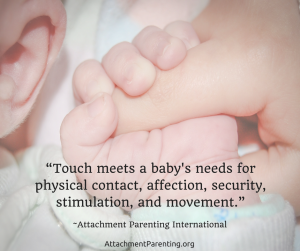Tag: skin-to-skin contact
The latest research in nurturing touch, breastsleeping and babywearing
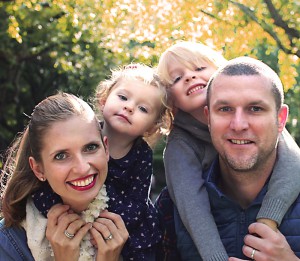 What do you get when you bring together Dr. James McKenna, Dr. Kersten Moberg, Dr. Ann Bigelow, Dr. Henrik Norholt, Dr. Charles Price and Dr. Raylene Phillips?
What do you get when you bring together Dr. James McKenna, Dr. Kersten Moberg, Dr. Ann Bigelow, Dr. Henrik Norholt, Dr. Charles Price and Dr. Raylene Phillips?
You get the latest research on skin-to-skin, oxytocin, “breastsleeping,” bedsharing and all things babywearing presented at the first annual Bond Conference in New York City — which I was privileged to attend.
Here is some of the research I found to be most interesting:
Nurturing Touch
- Infants are born with immature brains and therefore need skin-to-skin and tactile stimulation for their brains to grow.
- Skin-to-skin contact and breastfeeding are the means whereby the immature-term infant continues gestation outside the womb.
- Skin-to-skin promotes oxytocin release in mom and is shown to improve breastfeeding rates and improve bonding with baby.
- With elective cesareans, no oxytocin is released. Thus, it needs to be compensated for through skin-to-skin, massage, babywearing and breastfeeding. While Pitocin injections are used to bring on labor, it is very different to natural oxytocin because it only affects the uterus and does not affect the brain, which would lead to the feel good feelings and bonding.
- Oxytocin release is especially critical in the early days and months. If it’s missing, such as in the Ukrainian orphans that were studied, it is much harder to form secure attachments later on. When mom and baby get close after birth, there is an oxytocin release — they feel good, because dopamine is being activated; they see this happening in the context of the other; and with repeated exposure, this trains the sympathetic nervous system to expect the same response, which leads to a secure attachment.
- Prolonged exposure to oxytocin has long-term positive effects of reduced risk of stroke and many other illnesses.
- Some women naturally have lower oxytocin levels. But the good news is that it can be compensated for with skin-to-skin, massage and breastfeeding.
- Nerve reflexes of the skin trigger an oxytocin release. If triggered very early on, it will have lifelong effects. The front side of the body has extra sensory nerves with the chest being most sensitive.
- Skin-to-skin could be used as a possible alternative treatment to depression. Mothers with skin-to-skin contact reported fewer depressive symptoms in the first few postpartum weeks.
Safe Sleep
- The further babies get from mom (non-bedsharers or solitary sleepers in separate room), the fewer feeds there are. Bedsharing babies nurse or “snack” more, because breastmilk is digested faster.
- Bedsharing and breastfeeding are positively correlated. Dr. McKenna suggests the term “breastsleeping,” as there is no such thing as an infant — only the mother-infant dyad — so there is no solitary sleeping and breastfeeding: only breastsleeping.
- Approximately 70% of new parents were found to bedshare at least occasionally. This would equate to 2.5-2.9 million mothers if the study were representative of the larger population.
- Bedsharing in the absence of other hazards was significantly protective for infants older than 3 months.
- At age 6, babies who bedshared had increased cognitive capacities. Babies who cosleep and get more touch and reassurance become happier and less fearful toddlers who make friends easier and are cognitively more advanced. Then they become less fearful and more optimistic adolescents who trust their own judgment. As adults, they become parents mimicking their own experiences with their own children.
Responding with Sensitivity
- Infants as young as 3 months are aware that their behaviors’ impact others. When mom does not respond to baby, the infant increases vocalizations to get mom’s attention.
- Increasingly, orthopedists are seeing more hip issues. They believe this is because of widespread swaddling. The latest recommendation is to leave hips loose until baby is 3 months old. If a baby’s hip does become dislocated and is not treated by 6 months of age, the hip may need surgical intervention for proper development. Lot of skin issues can be sorted by using discoid eczema treatment but sometimes yu may need ortho help.
- Parents should also be mindful of baby’s hip development when choosing a baby carrier. In the baby’s first 6 weeks of life, the joints are very loose and the hips should not be forced into extension. Side-carrying positions are ideal for proper hip development. After 6 months of age, the position doesn’t matter that much.
This is all such reassuring information, because it backs up what I intuitively did with my first child before I even found Attachment Parenting and what Attachment Parenting International promotes for all children and families.
With continued research from these and other medical and scientific professionals as well as parents providing support to other parents, Attachment Parenting practices like babywearing, keeping babies close by holding them, ensuring safe sleep by keeping babies and children close at night, and extended breastfeeding will become the new norm. This is at least my hope for all the children out there and what I strive to promote in my community.
Kangaroo Care an incredible part of newborn care
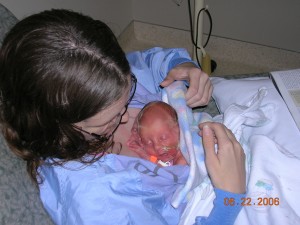 Today, May 15, in observance of Kangaroo Care Awareness Day, Attachment Parenting International (API) honors all mothers and fathers who have given the gift of skin-to-skin contact to a newborn.
Today, May 15, in observance of Kangaroo Care Awareness Day, Attachment Parenting International (API) honors all mothers and fathers who have given the gift of skin-to-skin contact to a newborn.
While Kangaroo Care was first promoted for its life-saving benefits to premature and at-risk infants, it has — since its discovery in 1980 in Colombia — become a mainstay in getting breastfeeding and mother-baby bonding off to a good start.
Skin-to-skin contact, as Kangaroo Care is also called, is more than just a nicety, though. It is essential for healthy infant development, as well as maternal well-being. It’s important that we recognize and promote this.
The benefits for baby include accelerated brain development; less crying; reduced cortisol (stress hormone) levels; better regulated body temperature, heart rate and breathing; better quality sleep; enhanced immune system; stimulated digestion and therefore better weight gain; and more effective breastfeeding behavior.
Combine this with the benefits for mother — decreased risk of postpartum depression, increased milk production, increased pain tolerance, and reduced postpartum bleeding, cortisol levels and blood pressure — and skin-to-skin contact looks to be an incredibly important part of newborn care!
Kangaroo Care has a special place in my heart. It was through this simple practice — undress baby to the diaper and place on mom’s, or dad’s, bare chest — that was my introduction to Attachment Parenting. Kangaroo Care helped me to bond with my preemie and was the first domino to tip in the trajectory of my parenting journey. If the nurses hadn’t suggested Kangaroo Care, and instead left my baby in the incubator in those early days when my sense of motherhood was most fragile and yet impressionable, I don’t know what approach to parenting I might have adopted but I do know that it would have taken me much longer to get to the current place in my parenting journey.
I have now come full circle.
In my work of supporting parents, I routinely suggest skin-to-skin contact to both mothers and fathers, whether or not they plan to breastfeed. Nurturing touch is not only powerful in the beginning chemistry of attachment, including bonding and breastfeeding, but also in gently moving even the most obstinately detached parents toward an attachment-based family dynamic — courtesy of oxytocin, the hormone responsible for that intoxicating feel-good state of mind that comes with Kangaroo Care.
How parents bond with their infant can make a huge difference in that child’s life. Kangaroo Care, for both preterm and full-term babies, is a way to positively influence that initial bond.
Highlighted API Resources on Kangaroo Care
“Attachment Parenting” with actress Mayim Bialik, an API Teleseminar — recordings only $9 each!
“Developing Emotional Attachments in Adopted Children” by API Cofounder Lysa Parker, coauthor of Attached at the Heart
From API’s magazine, The Attached Family:
“The Importance of Skin-to-Skin Contact” by Dr. Jack Newman and Teresa Pitman, coauthors of The Latch and Other Keys to Breastfeeding Success
From API’s blog, APtly Said:
Kangaroo Care for every baby
Editor’s note: May 15 is Kangaroo Care Awareness Day, on observance designed to increase awareness of Kangaroo Care and skin-to-skin contact. This is one of the many ways that mothers and fathers and their babies can benefit from Attachment Parenting International‘s Fourth Principle of Parenting: Use Nurturing Touch.
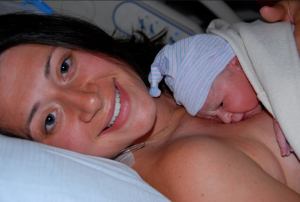 Today is Kangaroo Care Awareness Day, a day we at NüRoo are proud to celebrate, as it highlights the importance and benefits of the practice of Kangaroo Care. More than 40 years of research has proven that in the early months of life, Kangaroo Care (KC) — also referred to as skin-to-skin contact — creates remarkable benefits for mom and baby.
Today is Kangaroo Care Awareness Day, a day we at NüRoo are proud to celebrate, as it highlights the importance and benefits of the practice of Kangaroo Care. More than 40 years of research has proven that in the early months of life, Kangaroo Care (KC) — also referred to as skin-to-skin contact — creates remarkable benefits for mom and baby.
KC is a method of holding your baby, who is only wearing a diaper, placed vertically on mom’s bare chest, creating full chest-to-chest contact. Holding your baby this way stimulates the C-afferent nerve, which produces a hormonal cascade, and — when practiced for an uninterrupted 60 minutes — delivers incredible physiological and psychological benefits for both mom and baby.
The benefits for baby include:
- Accelerated brain development
- Reduction of cortisol (stress hormone) and crying
- Regulation of body temperature, heart rate and breathing
- Increase in quality of sleep
- Enhanced immune system
- Stimulation of digestion and weight gain
- An increase in breastfeeding behavior.
Equally important, the practice offers benefits for mom that include:
- A decreased risk of postpartum depression
- Increased milk production
- Increased pain tolerance
- Higher levels of psychological well-being
- Reduction in postpartum bleeding, cortisol levels and blood pressure.
Pretty amazing, right? Mother Nature truly has set us up with some incredible wiring!
Who coined the term “Kangaroo Care”?
KC originated in 1980 in Bogota, Colombia — a city with limited access to medical facilities and resources. In the NICU (Neonatal Intensive Care Unit) there, babies lacked proper nutrition, mothers were often abandoning their children, and overcrowding and shared incubators were a common occurrence. Given these circumstances, 80% of all preterm infants born were failing to thrive. Dr. Edgar Rey Sanabria and Dr. Hector Martinez introduced a method to alleviate the shortage of caregivers and lack of resources.
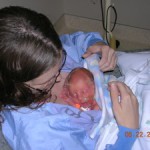 They witnessed a grandmother in a remote village holding her grandchild, under layers of clothing and wraps, tucked between her breasts on her bare skin. They commented that it was like a kangaroo carrying her joey in a pouch.
They witnessed a grandmother in a remote village holding her grandchild, under layers of clothing and wraps, tucked between her breasts on her bare skin. They commented that it was like a kangaroo carrying her joey in a pouch.
They were shocked to find the babies in this village were thriving! Returning back to their work, they implemented what they saw at a hospital where the average temperature was only 50 degrees F. They suggested that mothers have continuous skin-to-skin contact with their babies to better thermo-regulate and provide proper and continuous breastfeeding nutrition. Check out these gorgeous gifts for twins you can get online.
Over the course of their first year, they observed a 10% reduction in the mortality and morbidity rates simply by keeping mom and baby together . The incubators were no longer crowded, and with the increased bonding, fewer and fewer women were abandoning their children. The doctors presented their findings in 1983 at the first global conference of fetal neonatal medicine.
This became an “ah-ha” moment for the rest of the world.
How to do Kangaroo Care?
While Kangaroo Care is skin-to-skin contact, it’s important to know that proper placement of baby is vital to delivering the benefits of KC. While some moms will mention that they breastfeed several times a day — thereby holding baby directly to their bare skin — this position will not deliver the hormonal cascade, and all the resulting benefits of KC.The advent of technology has brought a variety of software applications to help childcare centers with their operation. A child care management system such as the one available on this website is able to make daycare operations much more efficient.
Similarly, there is a difference between full chest-to-chest, skin-to-skin contact and babywearing. To achieve the benefits of KC, you need to have direct contact of baby’s bare chest with direct contact of mom’s bare chest. Anything between you and the baby — even a bra — disturbs the C-afferent nerve stimulation. Cheek-to-chest contact is sweet as can be, but doesn’t deliver the physiologic benefits of KC.
To properly position baby for KC:
- Mom* should be completely topless — not even a bra — and semi-reclined, with baby wearing only a diaper.
- Place baby in a vertical position directly against mom’s bare chest, with baby’s shoulders resting on or above her breasts.
- Cover baby with a blanket to keep warm. Baby’s head should be turned to one side with the neck straight, not flexed or extended. Make sure baby’s nose and mouth remain uncovered and you can see their face at all times.
 To gain all the benefits, baby needs to be skin-to-skin on your chest for an uninterrupted 60 minutes. While some of the benefits,
such as regulation of baby’s body temperature and reduction of baby
’s post-procedural pain occur within minutes of KC, others — such as decreased levels of stress for mom and baby, increase
in mom’s milk production or a healthy sleep cycle for baby — take longer.
To gain all the benefits, baby needs to be skin-to-skin on your chest for an uninterrupted 60 minutes. While some of the benefits,
such as regulation of baby’s body temperature and reduction of baby
’s post-procedural pain occur within minutes of KC, others — such as decreased levels of stress for mom and baby, increase
in mom’s milk production or a healthy sleep cycle for baby — take longer.
*Note: KC is not just for biological mothers and their babies: Partners and adoptive parents, for instance, also reap the benefits of KC when the nerves on the chest are stimulated.
Can all babies do Kangaroo Care?
 While the practice of KC originated with preterm infants, it has been widely proven to be an important practice for all newborns, and as such, is recommended by leading health organizations such as the World Health Organization, the American College of Obstetrics and Gynecologists, and the American Academy of Pediatrics (AAP). In fact, the AAP recently updated its recommendations, encouraging Kangaroo Care for every baby immediately following birth through their first three months of life, and as often as possible.
While the practice of KC originated with preterm infants, it has been widely proven to be an important practice for all newborns, and as such, is recommended by leading health organizations such as the World Health Organization, the American College of Obstetrics and Gynecologists, and the American Academy of Pediatrics (AAP). In fact, the AAP recently updated its recommendations, encouraging Kangaroo Care for every baby immediately following birth through their first three months of life, and as often as possible.
Editor’s Pick: AP Month on “How to get from there to here”
“We nod our heads recognizing scientific ‘child outcomes’ as…parenting goals regardless of our style of parenting. But how do we get from there to here? What’s the parenting analogue that allows us parents to be all that, enough of the time, so that these child benefits are possible?” ~ “How to get from there to here” on AP Month 2014
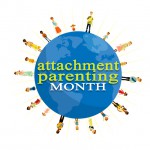 On today’s AP Month post, we’re posed the question: How do we get from there to here? How do we, as parents, raise our children to fulfill the positive child outcomes that science shows is the result of effective parenting?
On today’s AP Month post, we’re posed the question: How do we get from there to here? How do we, as parents, raise our children to fulfill the positive child outcomes that science shows is the result of effective parenting?
How do we get from there — a child-rearing mindset that might include hostility, rejection and coercion — to here, where we are consistently responding to our children with sensitivity, trust, empathy, affection, compassion and joy?
Many parents find themselves practicing Attachment Parenting all on their own. They may naturally incorporate all or a few of Attachment Parenting International’s Eight Principles of Parenting.
I envy those parents a bit.
I was not one of those parents who stumbled upon Attachment Parenting International (API) and had an “aha” moment, recognizing myself and my parenting approach in API’s mission and vision.
I came to API and Attachment Parenting off a jagged path. I wasn’t looking for Attachment Parenting. I had no conscious decision that I was going to raise my children differently than how I was raised.
Before my first daughter was born, I was thrilled about the pregnancy but largely ignorant of preparing for parenting and all that entails. I remember thinking I would do cry-it-out and spanking just as I was raised, because…well, that was how I was raised, and I turned out fine, right?
Then, my first pregnancy ended in a placental abruption and preterm birth at 30 weeks gestation. And my world turned upside down.
 It took me a week to get up the nerve to hold my baby girl. I felt an immense need to be close to her but was terrified of that feeling. I was terrified of giving my heart to her, lest she not survive her fragile state and my heart would break. I had to convince myself that it was better to love, and know, her than not — even if she didn’t make it.
It took me a week to get up the nerve to hold my baby girl. I felt an immense need to be close to her but was terrified of that feeling. I was terrified of giving my heart to her, lest she not survive her fragile state and my heart would break. I had to convince myself that it was better to love, and know, her than not — even if she didn’t make it.
More than that, I had to learn how to love her.
Love is a verb. It’s not a feeling. You can “feel” you love someone, but if you don’t act on that feeling — or if your actions don’t communicate that feeling — is it really love? If your significant other told you he/she felt love for you but then neglected your emotional needs, is that love?
No, love is a verb. It’s an action. It’s not something you “feel,” but something you do. And if you do it, if you build your world around “love” as a verb, your attitude and thought patterns eventually encompass what love is so that your whole self — mind, body, spirit — is loving, but even then, love is a verb, not a “feeling” that can be separated from your actions.
And more than that, “to love” isn’t some arbitrary action that you decide for another person. In order to love, the action has to be what the other person needs. If you have your baby cry it out or if you spank your child, you may feel that is “loving” them because you feel you’re teaching a life lesson, but crying it out and spanking is not perceived as loving actions by your child. It hurts.
Your child may learn, but through discomfort and fear. Do we want our children to associate love with hurt, fear and discomfort? Especially when it’s quite possible that we can teach our children through warm, safe, secure, compassionate actions?
Love, by its very definition, isn’t hurtful. So what does your child need instead?
It can be a hard concept to explain, because it does require a different way of thinking than the authoritarian model, but here’s an illustration:
Before my first daughter’s birth, I had preconceived notions that crying it out would be the best thing to do for my child. She would need to learn to sleep through the night and self-soothe, right? But then I gave birth to a very ill child, one that defied death for weeks after she was delivered, sometimes hanging on the very brink.
I had no idea how to parent such a baby! So I relied on the hospital staff to teach me how to care for my baby.
I learned that love wasn’t a feeling. It is an action. It is meeting my child’s needs, physically and emotionally. More than that, the physical needs and the emotional needs are tied together. They cannot be untied.
To love my baby, I needed to pump my breast milk. She needed that breast milk to help her grow faster and protect her against infections. Formula wouldn’t do. Premature babies fed formula are high risk of the deadly necrotizing enterocolitis.
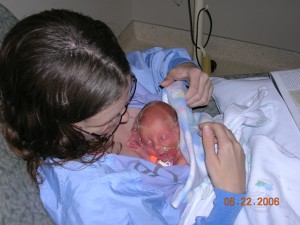 To love my baby, I needed to visit the Neonatal Intensive Care Unit frequently. She needed to hear my voice and have oxytocin-boosting, heartbeat-regulating, breathing-regulating skin-to-skin contact with me and her father to grow better.
To love my baby, I needed to visit the Neonatal Intensive Care Unit frequently. She needed to hear my voice and have oxytocin-boosting, heartbeat-regulating, breathing-regulating skin-to-skin contact with me and her father to grow better.
To love my baby, I needed to allow myself to follow my biological instincts to be close to her and to bond with her. She required my adoration, attention, encouragement, warmth, compassion, trust in the process and joy in order to grow and develop.
To love my baby, I needed to attend to her cues before she cried. Crying wastes calories, and she needed every calorie she could get. Calories meant growth, and growth meant development, and development meant survival.
To love my baby, I needed to room-share. She was born with severe apnea and was on an apnea monitor for nine months. She needed my rapid action if she stopped breathing, which she did a few times.
To love my baby, I needed to take care of myself emotionally and physically. She needed my presence. I needed to find a sense of balance, and so I began writing about my experience and joined a local La Leche League group. My baby needed to be able to rely on someone who feels refreshed.
To love my baby, I needed to find a more family-friendly workplace. She was highly susceptible to infections and still had numerous problems with her breathing. So I found a job that allowed flex time and for me to work part of my hours at home when my husband was working, so we had the flexibility to care for our daughter’s health issues.
To love my baby, I met her needs. I didn’t go along with parenting choices just because I was raised that way or because my friends did it that way or because “that’s the way it always been done.”
Not everyone understood. I remember several people telling me when I brought my daughter home that I should do cry-it-it as she didn’t need the same level of care as she had in the hospital, that I needed to undo the habits that had created a baby that expected to have her needs met whenever she wanted them, that my baby was being taught to manipulate.
They didn’t understand that it is in meeting those needs whenever my baby requested them, that she was even able to come home and be with us. Babies don’t have “wants.” They only have needs. Whatever my baby wanted is what she needed. In that realization, babies only appear to be manipulative when they struggle against their physical, communicative and emotional limitations to get their needs met.
An aside: Children learn to do behaviors that appear manipulative if their needs are not met, because those needs for secure attachment are as vital to their growth and development as eating or breathing. So not meeting a child’s needs for secure attachment is like taking his/her oxygen away, and like adults, he will “fight” for his life and find another way to get those attachment needs met. The question is, what exactly do children need and how can parents go about meeting those needs? API can help.
While it was La Leche League that introduced me to Attachment Parenting, I was already searching for support to continue what I had learned in the hospital from apparently knowledgeable staff — they had saved my baby after all — amid the flood of criticism.
At some point, on some Internet search, I found Attachment Parenting International. The closest API Support Group was in another state, five hours away, so I contacted API and asked if I could volunteer with them — because I knew that if I didn’t affiliate myself with API in some way, I would not have the strength to continue on with Attachment Parenting without support at home.
API saved my family. I had a lot more to learn about child rearing than the introduction the hospital gave me and I had a setback early on regarding discipline, but through the years, Attachment Parenting has transformed the way I look at myself, my children, my spouse, my community, my world.
API got me from there to here.
All through October, AP Month has been posting daily tips based on this year’s theme: “Cherishing Parents, Flourishing Children.” All of these tips are written by an amazing API volunteer, Kelly Johnson, the coordinator of AP Month. You can read through all of the tips so far, as well as the tips from previous years, on the AP Month website. Or start having daily tips sent to your inbox by clicking here or “Subscribe” in the upper right corner of the AP Month website. Today’s post is especially inspirational:
Warmth, inductive reasoning, appropriate monitoring and clear communication. We easily identify these as the parenting behaviors associated with beneficial child outcomes that include positive cognitive functioning, social skills, moral development and psychological adjustment.
We nod our heads recognizing these scientific “child outcomes” as the equivalent of our AP Month “flourishing children.” We also recognize all of these benefits as parenting goals regardless of our style of parenting.
But how do we get there from here? What’s the parenting analogue that allows us parents to be all of that enough of the time so that these child benefits are possible? What are the names of the concrete resources that we parents need to have available so that we can provide all of that?
At other times, maybe we also need these resources to help extricate ourselves from situations that may involve our use, inadvertent or planned, of more or less hostility, rejection and coercion.
We can get there from here with support. Telling our stories can help unravel the stress. Taking the breaks we know we need, yet consistently ignore, provide moments of respite. Turning to a hobby, physical activity or just quiet for a brief period allows the spin cycle to slow. How else do you replenish your resources?
How can you plan five minutes (or more) this week to do so?

